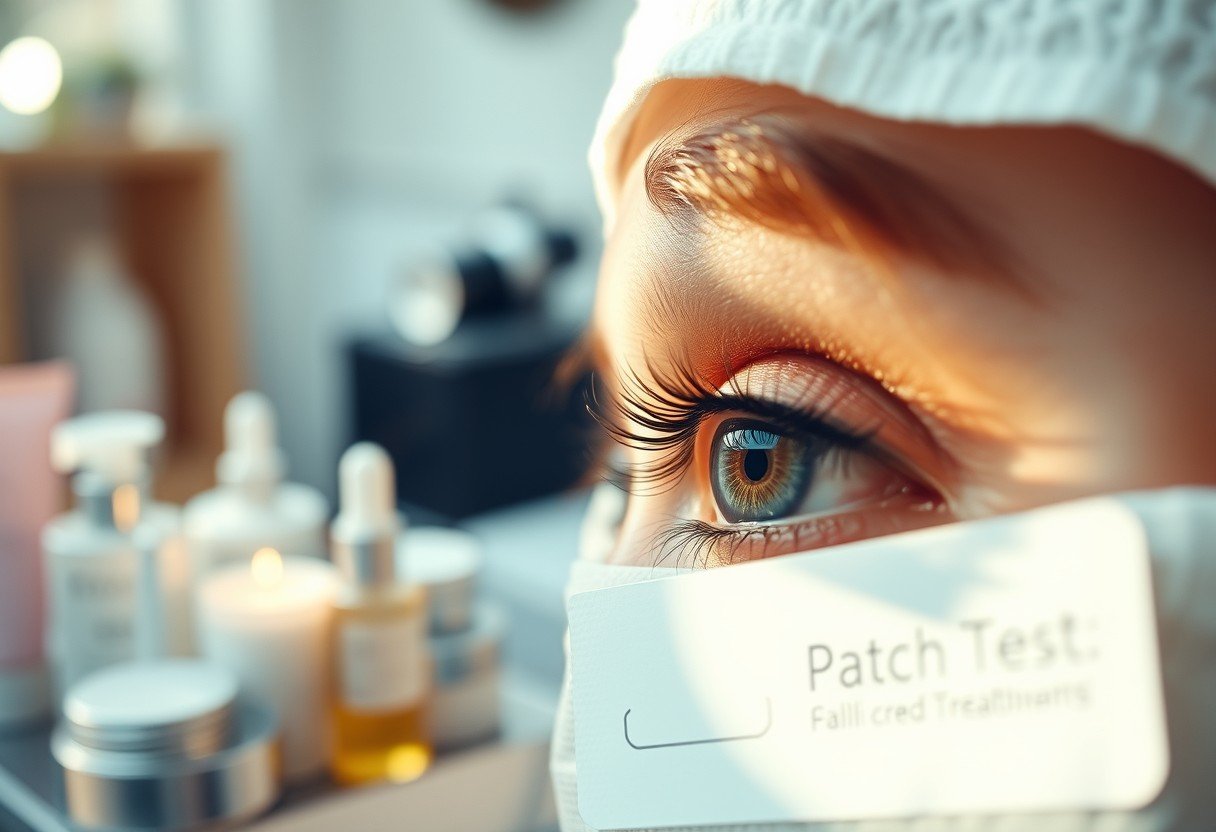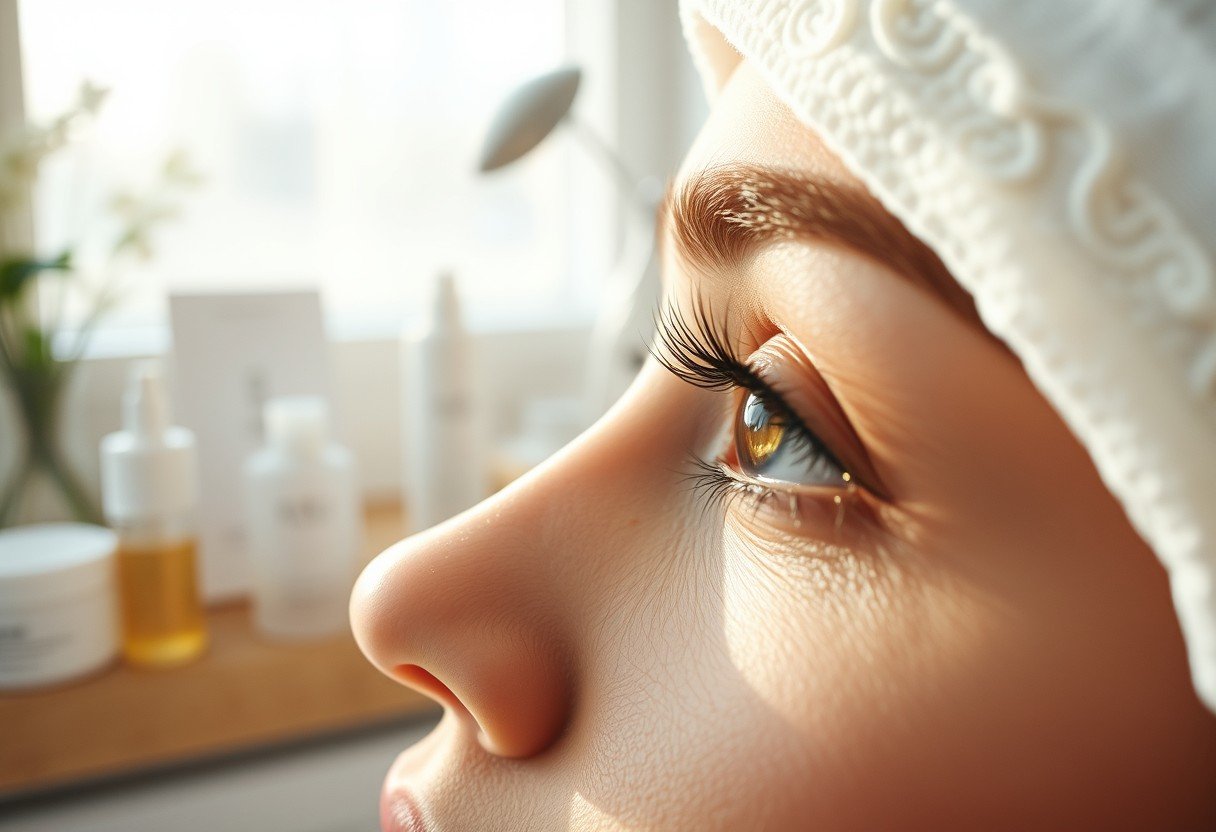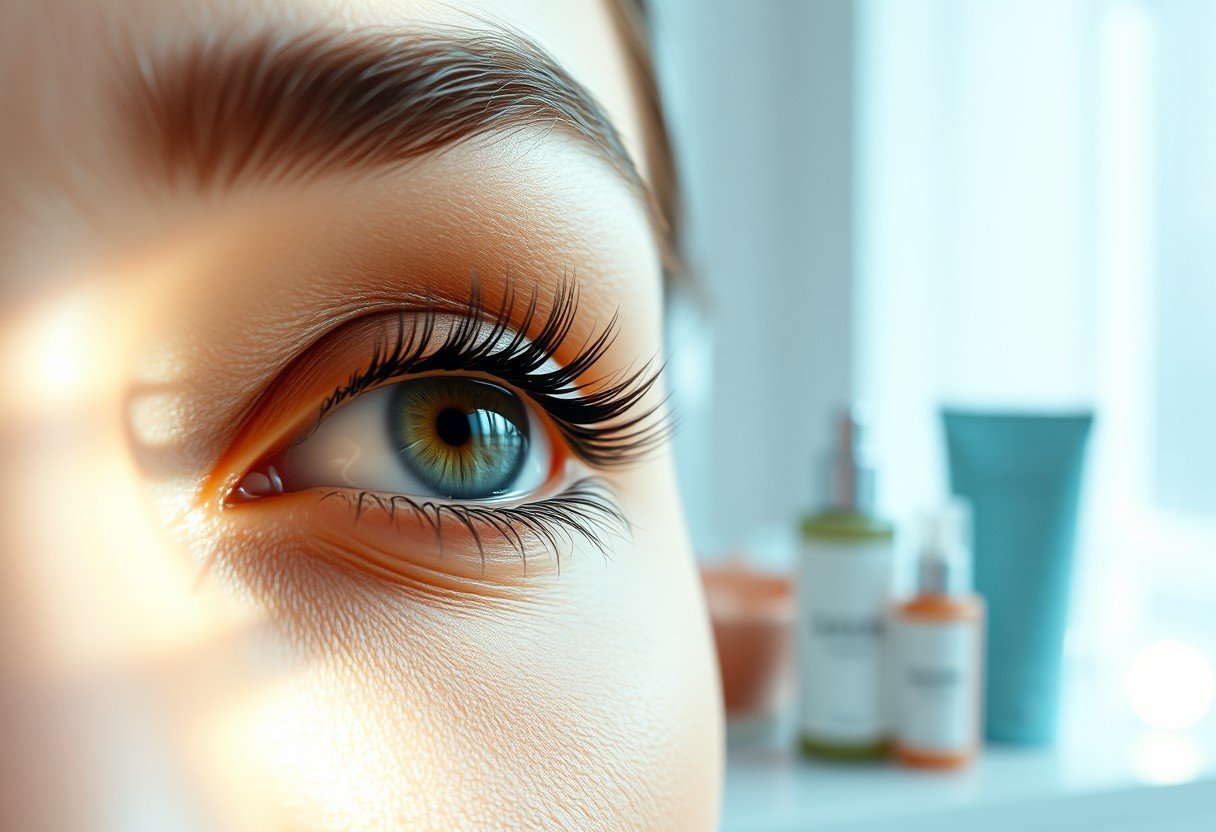Treatments for your eyelashes and brows can significantly enhance your look, but without appropriate precautions, they can also lead to adverse reactions. Patch tests are important for identifying any potential allergies to the products used during these treatments. By taking a few moments to conduct a patch test, you protect yourself from serious discomfort or skin reactions that may occur post-treatment. Ensuring your skin’s compatibility with the products will not only ensure your safety but also boost your confidence in achieving beautiful results.

Key Takeaways:
- Skin Sensitivity: Patch tests help identify any potential allergic reactions or skin sensitivities before undergoing eyelash and brow treatments.
- Safety Assurance: By conducting patch tests, beauty professionals can ensure the safety and comfort of clients, minimising the risk of adverse effects during the procedure.
- Long-Term Effects: Early detection of negative reactions can prevent long-term damage or complications, ensuring healthier skin around the eye area.
Understanding Patch Tests
A patch test is an vital precaution that you should not overlook before undergoing eyelash and brow treatments. By conducting this simple test, you can verify your skin’s reaction to the products being used, ensuring your safety and comfort throughout the procedure. If you’re curious about what are patch tests and why are they so important?, you’ll find that a patch test can save you from unexpected allergic reactions or irritations that may arise from the ingredients present in these beauty products.
Definition of Patch Tests
Tests are designed to identify any potential adverse reactions your skin may have to various substances before you undergo a treatment. This is particularly crucial in beauty services, where harsh chemicals or allergens might be used in products applied to your eyelashes or brows. A patch test typically involves applying a small amount of the product on a discreet area of your skin, usually behind your ear or on your wrist, and observing it for any signs of irritation over a set period.
By performing a patch test, you can gain the confidence that you won’t experience severe allergic reactions or skin complications during your eyelash and brow treatments. This small step acts as a protective measure between you and the potential risks associated with beauty products.
Purpose of Patch Tests
An important aspect of patch tests is to ensure that your skin does not react adversely to the products that will be used during your treatment. Each individual’s skin can respond differently to chemicals and compounds found in beauty products, which makes it crucial for you to be aware of your skin’s sensitivities. By identifying any potential reactions, you can discuss alternatives with your beauty technician or opt for treatments that are safer for your skin type.
Purpose. Additionally, patch tests play a vital role in preventing discomfort or health issues that may arise from using an unsuitable product. If you were to experience an allergic reaction during your treatment, it could lead to severe inflammation, redness, or even *long-lasting skin damage*. Demonstrating your commitment to your skin’s health by undertaking a patch test sets the groundwork for a more enjoyable beauty experience.
Commonly Tested Substances
Tested substances in patch tests typically include the specific dyes, adhesives, and pigments used for lash extensions or brow tinting. For example, the *P-phenylenediamine (PPD)* found in many brow dyes can provoke strong reactions in sensitive individuals. Similarly, the adhesives used to attach lash extensions often contain chemicals that can cause irritations if your skin is reactive to them.
Being proactive and aware of these substances can help you make informed choices about the treatments you undergo. With this knowledge, you can effectively communicate your concerns to your beauty technician, ensuring that the products used are suitable for your unique skin type and sensitivity.
With that in mind, it’s worth mentioning that always *prioritising patch tests* can significantly reduce the risk of adverse reactions. By routinely undergoing this simple procedure before any treatment, you place your skin’s health at the forefront, allowing you to enjoy the benefits of beauty treatments without the worry of unwanted side effects.
Risks of Eyelash and Brow Treatments
There’s no denying that eyelash and brow treatments can enhance your appearance dramatically. However, it’s vital to understand the potential risks associated with these beauty procedures. From allergic reactions to serious eye infections, being informed can help you make safe choices. When considering treatments like lash lifts, tints, or brow lamination, you should always prioritise conducting a patch test. Patch test before a Lamination treatment? This small step can help you avoid the unpleasant side effects that can arise from these popular treatments.
Allergic Reactions
Allergic reactions are one of the most concerning risks associated with eyelash and brow treatments. These reactions can manifest as redness, swelling, or itching around the eyes. In some cases, they may even lead to more severe complications, such as dermatitis or anaphylaxis. Understanding your skin’s sensitivity to various products is critical, especially since the chemicals used in these treatments can vary significantly from one salon to another.
In particular, the ingredients in lash adhesives and tinting solutions can often trigger unexpected reactions. If you have a history of allergies, it’s necessary to inform your beauty technician and take the necessary precautions to ensure your safety. Familiarise yourself with the common allergens in these products and consider requesting a patch test prior to your appointment. This precaution could save you from significant discomfort and potential harm.
Chemical Burns
On a more alarming note, chemical burns are a potential risk during eyelash and brow treatments. These burns generally occur due to improper application of products that contain strong chemicals, which can lead to pain, scabbing, and in severe cases, hair loss. It is crucial to seek services from professionals who follow proper procedures and use tested products. Always check that your technician is experienced and adheres to safety guidelines, as well as having a clear understanding of the ingredients used in their treatments.
A chemical burn not only causes discomfort but may also leave lasting damage, impacting your natural lashes and brows. Avoiding these types of injuries rests heavily on ensuring that a thorough patch test is performed, allowing you to gauge your skin’s reaction to the chemicals involved before the treatment proceeds.
Eye Infections
To further complicate matters, eye infections can arise from poor hygiene practices associated with these treatments. When products, tools, or hands come into contact with your sensitive eye area, the risk of transferring harmful bacteria increases. Symptoms may include pain, redness, discharge, and even vision problems if left untreated.
Eyelash extensions or poorly applied lash lifts can trap dirt and debris, which may also contribute to infections. It’s necessary to choose a reputable salon with stringent sanitation practices and to follow all aftercare instructions provided by your technician. This way, you can thoroughly protect your eyes and maintain their health long-term.

Benefits of Patch Testing
For anyone considering eyelash and brow treatments, understanding the benefits of patch testing is paramount. This imperative step acts as a safeguard against potential complications, ensuring that your beauty experience remains positive and safe. By investing a few moments into this preliminary process, you tremendously enhance the likelihood that your treatments will proceed without a hitch.
Early Detection of Allergies
An important benefit of patch testing is the early detection of allergies. By applying a small amount of the treatment solution to a discrete area of your skin, you can observe how your body reacts over 24 to 48 hours. This simple step can alert you to any adverse reactions, such as redness, swelling, or itching, that may occur if you were to undergo the full treatment without any preliminary assessment.
Identifying allergies prior to treatments not only avoids discomfort but also prevents severe reactions from occurring. You might find that some ingredients, although typically safe for most, can provoke unexpected sensitivities in your unique skin type. Therefore, this proactive measure is a wise decision for anyone wishing to maintain their safety and comfort during beauty procedures.
Customized Treatment Options
Patch testing also paves the way for customised treatment options. Once you know how your skin responds to the test, you can discuss alternatives or adjustments with your technician that cater specifically to your needs. This might include choosing hypoallergenic products or adjusting the techniques used to apply the treatments.
Options that consider your individual responses ensure that you receive the best possible outcome from your eyelash and brow treatments. Personalised products and methods not only enhance your comfort during the process but also contribute significantly to the overall success of your beauty routine.
Reduction of Treatment Side Effects
Detection of any adverse effects begins with patch testing, leading to a substantial reduction of treatment side effects. When you can identify a negative reaction in advance, you minimise the risk of facing problems post-treatment, such as prolonged irritation or unwanted discolouration. This early indication is crucial, as it allows you to make informed choices regarding the products and techniques that will best suit your skin.
Early identification of potential side effects can save you from a range of unpleasant experiences that might otherwise arise. Moreover, by addressing these concerns upfront, you are likely to enjoy a smoother, more effective treatment process with minimal disruptions.

The Patch Test Process
Unlike many beauty treatments, an crucial step in eyelash and brow enhancements is the patch test. This preliminary step is vital to ensure your skin can tolerate the products used during the procedure. Many individuals overlook the significance of a patch test, but it can prevent potentially serious adverse reactions. By taking the time to conduct this test, you are prioritising your health and safety while enhancing your beauty.
Consultation with a Professional
Process begins with a thorough consultation with a professional. This meeting is an opportunity for you to discuss any skin sensitivities or previous reactions you may have experienced. Your beauty technician will assess your skin type and recommend appropriate products that minimise the risk of an adverse reaction. This dialogue is crucial as it sets the groundwork for a safe and effective treatment.
During this consultation, you should not hesitate to ask questions about the products to be used. A knowledgeable technician will provide information about the ingredients, ensuring that you understand what may come into contact with your skin. This transparency helps to build trust and prepares you for the patch testing process.
Procedure for Conducting a Patch Test
On the day of your patch test, a small amount of the product will be applied to a discreet area of your skin, typically behind the ear or on the inner arm. This allows for close monitoring as these areas are easy to observe for any possible reactions. This initial application remains on your skin for approximately 24 to 48 hours to accurately assess any potential allergies.
To ensure the integrity of the results, it is vital to avoid applying any other products to the test area during this period. Keep an eye on the area and be vigilant for signs such as redness, swelling, irritation, or even blisters. If you notice any concerning symptoms, contact your professional immediately.
Interpreting Test Results
Patch testing outcomes can greatly influence your choice to proceed with eyelash and brow treatments. Patch test results are typically interpreted as either positive or negative. A negative result means you are likely safe to proceed, as no adverse reactions were observed. This allows you to enjoy your beauty enhancement with greater confidence. However, should you receive a positive test result, it indicates your skin has reacted negatively, signalling that the product should not be used on you.
Conducting patch tests consistently is good practice, even if you’ve had previous treatments without issues. Each product formulation can differ, and your skin’s sensitivity may change over time. If you experience a reaction during the test, ensure to inform the technician to explore alternative products or procedures that are safe for your skin type.
Post-Patch Test Considerations
To ensure that your eyelash and brow treatments proceed smoothly and safely, it is important to consider a few key factors following your patch test results. The successful completion of a patch test does not provide an absolute guarantee that you will not experience any adverse reactions during or after treatment. It is vital for you to remain vigilant and aware of how your skin reacts to products, especially if you are undergoing a new treatment or using unfamiliar products.
Recommended Waiting Period
Considerations surrounding the recommended waiting period should not be overlooked. After receiving your patch test, it is generally advised to wait at least 24 to 48 hours before proceeding with any eyelash or brow treatments. This waiting period allows you sufficient time to observe your skin reaction to the tested products, ensuring that no delayed hypersensitivity emerges. If, at any point during this time, you notice any unusual symptoms, it is crucial to communicate these with your technician.
Signs of Adverse Reactions
On the other hand, it is equally important to understand the signs of adverse reactions that may manifest after your patch test. Be on the lookout for symptoms such as redness, swelling, itching, or any type of skin irritation in the tested area. If you experience any of these signs, it is advisable to discontinue using the product and consult a medical professional or dermatologist for further assessment. Taking these precautions can protect your skin from the risks associated with potential allergic reactions.
For instance, severe reactions can escalate quickly, leading to complications such as dermatitis or even more serious conditions. Recognising your body’s signals early on can make a significant difference in preventing extensive damage. Always prioritise your safety and consult with a professional if in doubt.
Safe Treatment Practices
Period is another critical period which encompasses the best practices for safe treatments. After your patch test, choose a reputable salon or practitioner who adheres to strict hygiene standards. Ensure that they use high-quality, hypoallergenic products whenever possible. Also, remember to inform your technician about any previous adverse reactions you may have had to similar treatments to ensure the best approach is taken with your procedure.
The knowledge and diligence surrounding safe treatment practices cannot be emphasised enough. Always conduct thorough research on the products that will be applied during your treatment and ensure that they are suitable for your skin type. Your safety should always be the number one priority when indulging in beauty treatments. By following these guidelines, you can enjoy your eyelash and brow treatments with peace of mind, knowing you’ve taken all necessary precautions.
Common Misconceptions
All too often, individuals underestimate the importance of patch testing before eyelash and brow treatments. One of the most prevalent misconceptions is the belief that patch tests are only necessary for severe allergies. However, this notion can lead to significant complications. The reality is that even those who have never experienced allergic reactions may develop sensitivities to new products, especially with frequent changes in formulations. You’ll never truly know how your skin or eyes will react until you conduct a patch test. By disregarding this precaution, you run the risk of encountering unexpected and potentially devastating reactions.
The consequences of dismissing patch tests can be far-reaching, as even mild irritations can escalate quickly. Skin around the eyes is particularly delicate, making it imperative that you err on the side of caution. By investing this minimal time for a patch test, you not only protect your own well-being but also avoid potential discomfort that may arise from your favourite beauty treatment.
One Patch Test Is Sufficient for All Treatments
An unfortunate misconception is that a single patch test can suffice for all types of treatments. While you may believe that once you’ve undergone a patch test for one product, it covers everything else, this is simply not the case. Different products contain varying ingredients, and you could experience an allergic reaction to any new formulation. Therefore, it is crucial that you conduct a patch test for every new product or treatment you consider using.
Common practices often suggest that a patch test should be done for every visit, particularly when treatments involve different brands or formulations. Each product carries its unique chemical makeup, which could potentially trigger an allergic reaction. It’s vital that you take this step seriously, as skipping it can lead to unwanted outcomes.
DIY Patch Testing Is Reliable
For some, the idea of conducting your own patch test seems like a convenient option, leading to the assumption that DIY patch testing is reliable. Yet, this can be misleading. While it may appear easy to conduct a simple test at home, various factors come into play. You may lack the precise knowledge of the products, understand the importance of correct application, and properly interpret the results, which can lead to significant misjudgements.
Patch testing conducted in a professional setting guarantees that a trained technician oversees the process. They are aware of the signs of potential reactions and can advise you on the outcomes effectively. Trusting your own DIY method may leave you with a false sense of security, which ultimately puts you at risk.
Summing up
Upon reflecting on the importance of patch tests before begining on eyelash and brow treatments, it becomes clear that these preliminary assessments are vital for safeguarding your skin and overall health. By conducting a patch test, you can identify any potential allergic reactions to the products being used, which could otherwise lead to discomfort or even serious health issues. This simple yet crucial step not only enhances your safety but also contributes to a more enjoyable and worry-free beauty experience. You owe it to yourself to ensure that the products applied around your eyes, one of the most sensitive areas of your body, are suitable for your skin type.
Ultimately, prioritising a patch test is an act of self-care that reflects your commitment to both beauty and well-being. By taking this precaution, you empower yourself to enjoy the benefits of eyelash and brow treatments without the looming fear of adverse reactions. As you consider enhancing your look, remember that your safety should always come first; investing a little time in a patch test can save you from potential complications down the line. Embrace this responsible approach to beauty and enjoy the confidence that comes from knowing you are taking care of your skin’s needs.
FAQ
Q: What is a patch test and why is it necessary before eyelash and brow treatments?
A: A patch test is a small application of the product used during eyelash and brow treatments, placed on a discreet area of the skin, typically behind the ear or on the inner arm. It is necessary to identify any allergic reactions or sensitivities to the ingredients in the product prior to the full application. This precaution helps to prevent severe allergic reactions, irritation, or other adverse effects during the treatment.
Q: How long before my appointment should I have a patch test done?
A: It is generally recommended to have a patch test performed at least 24 to 48 hours before your scheduled eyelash or brow treatment. This time frame allows for any potential allergic reactions to manifest, giving your technician the chance to conduct an alternative course of action should a reaction occur.
Q: What symptoms should I look out for after a patch test?
A: After a patch test, monitor the area for any signs of irritation, which may include redness, itching, swelling, or blistering. If you experience any of these symptoms, particularly if they occur shortly after the test, it is advisable to inform your technician and refrain from proceeding with the treatment to avoid further complications.
Q: Are there any specific individuals who should be more cautious about patch testing?
A: Yes, individuals with known sensitivities to cosmetics or allergies to certain ingredients should exercise extra caution. Additionally, those with sensitive skin or a history of skin reactions should always request a patch test, regardless of previous treatments, to ensure their safety.
Q: What happens if I do not perform a patch test before my treatment?
A: Skipping a patch test can pose significant risks, including severe allergic reactions, which may lead to discomfort, long-lasting skin damage, or even permanent loss of eyelashes or eyebrows. If a reaction occurs during the treatment without prior testing, it may complicate recovery and necessitate further medical intervention. Thus, it is always advisable to adhere to the patch testing protocol for your own safety.
